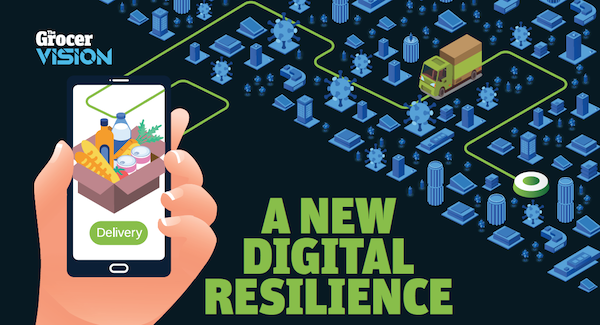The challenge for the grocery sector as lockdown hit in the UK was huge - product demand skyrocketed, employees became key workers overnight, shops had to restrict customer numbers while queues grew larger and the online grocery market was expected to boom by over 25%. We hosted a webinar with The Grocer to learn more from Waitrose and Uber Eats on how they responded to the pandemic and built up their digital resilience for the future.
Lessons learned from the pandemic
The speed of change was a surprising challenge for both Uber Eats and Waitrose. Ben Stimson, Digital Director at Waitrose, explained there was a clear need to accelerate and adapt their plans for expansion as they doubled the size of their online business over just six weeks. Having to drastically scale up operations while being restrained by social distancing measures for employees and customers made the challenge even more difficult for retailers such as Waitrose.
How they responded
The immediate priority, explained Toussaint Wattinne, General Manager of Uber Eats UK and Ireland, was for the company to ensure the safety and wellbeing of their key stakeholders on both the supply and demand side - restaurants, couriers and consumers. In order to achieve this, they quickly introduced a package of measures such as contactless deliveries and providing masks and hand sanitisers to couriers.
Additionally, Uber Eats provided financial assistance to couriers who were either diagnosed with Covid-19, or asked to self-isolate by a public health authority. They then began providing solutions to the restaurant sector at speed and scale, after restaurant trade was hit hard financially by the lockdown and takeaways and deliveries quickly became the only way many restaurants and cafes were able to sustain their livelihoods. Uber Eats worked to support them with a range of initiatives including free delivery.
Uber Eats diversified to be resilient - they recognised the need for grocery deliveries before the pandemic, and as demand grew exponentially during lockdown, they developed a solution-oriented mindset and drove a team allowing retail merchants to be onboarded quickly, adapting their business model in order to accommodate delivering grocery essentials with rapid expansion.
Uber Eats is now beginning to understand the wealth of data they have from both the supply and demand side, in order to adapt their business to allow retail merchants to benefit from efficient, sustainable deliveries and sustained profitability through the model. Wattinne explained the need to understand the marginal gains from the data they hold, proving that to be resilient, businesses have to be patient and have an excellent understanding of their data.
At Waitrose, Stimson explained, he was asking difficult questions in order to utilise the pools of data they had, for example, on highlighting potentially vulnerable customers who needed priority delivery slots. All panellists at the webinar agreed that the need to access and democratise data quickly, and understand what questions can be answered from it, is immensely important, particularly during times of crisis and when building a strategy for digital resilience.
Building resilience
Salesforce recognised three key pillars in the challenge to develop agility and build more resilience to improve their online operations in a post-COVID-19 world. First of all, there was the need to respond intelligently. Many supermarkets were overwhelmed with social media messages, of which a majority were angry, and so they had no choice but to delay responses as a result of growing demand, or stop posting marketing at all.
This highlights the necessity for strong CRM software to deliver a strong customer experience at speed and scale without needing to immediately grow customer support capacity. The second pillar in building resilience was the need for agility. One customer had to close down their offshore call centre at short notice and was able to use Salesforce CRM to set up a new call centre the next day in the UK using remote technology to redeploy members of the business.
Grocery retailers faced a huge challenge with the pandemic, and as the world begins to return to normality, many grocery businesses are looking to the future to adapt with the changing consumer tastes and preferences. Suggestions for ways to maximise efficiency included delivering to multiple households in the same street using a kerbside or milk van style approach and encouraging click and collect through marketing campaigns to incentivise in-store visits are ways stores can increase profitability.
You can catch up on the Building Better Online Grocery webinar on-demand. Building digital resilience is important to business success, especially during times of crisis. With our New Retail Playbook, you can help your employees return to normality with ease and continue delivering excellent customer experiences. Learn more here.








